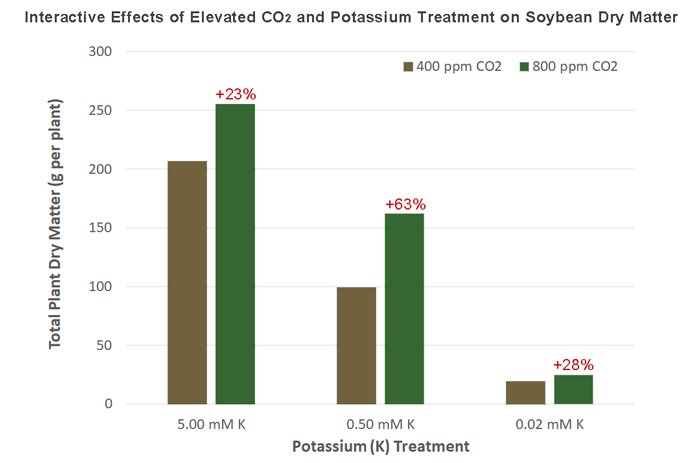| Follow @co2science |
Paper Reviewed
Singh, S.K. and Reddy, V.R. 2017. Potassium starvation limits soybean growth more than the photosynthetic processes across CO2 levels. Frontiers in Plant Science 8: 991, doi: 10.3389/fpls.2017.00991.
Introducing their study, Singh and Reddy (2017) note that potassium (K) is an important element taken up by plant roots; and they write that K deficiency "limits crop growth and yield by adversely affecting vital plan processes, such as water relations and cellular turgidity, cell expansion, assimilate transport, and enzyme activation." However, such growth limitations may be lessened and even overcome in the future as plants experience the many documented growth-enhancing, water-saving and stress-alleviating benefits of atmospheric CO2 enrichment. And in an effort to see if this is indeed the case, Singh and Reddy conducted an experiment to "investigate the interactive effects of K and CO2 levels on soybean photosynthesis, growth, biomass partitioning, and nutrient allocation and utilization efficiencies."
The experiment was conducted on soybean plants in controlled environment growth chambers at the USDA-ARS facility in Beltsville, MD, USA. Treatments included two levels of CO2 (400 and 800 ppm) and three levels of K (potassium nitrate, KNO3 -- a control level of 5.00 mM K and two deficient levels of 0.50 mM and 0.02 mM K). And what did those treatments reveal?
Results of the analysis revealed that K deficiency significantly reduced soybean growth-related parameters regardless of CO2 concentration. However, as illustrated in the figure below for total plant dry matter, elevated CO2 compensated and partially ameliorated the K deficiency-induced growth reductions such that the percentage growth enhancement due to elevated CO2 was greater (+63% and +28%) under the two levels of K deficiency (0.50 and 0.02 mM K) than when K was not a growth-limiting factor (+23% CO2-induced enhancement at 5.00 mM K level). Averaged across potassium treatments, elevated CO2 increased the leaf, stem, root and pod weight by 28, 68, 23 and 33 percent, respectively, at maturity.
Elevated CO2 was also found to improve both plant potassium use efficiency (KUE) and nitrogen use efficiency, where the values of each of these parameters was higher under elevated CO2 conditions for each level of potassium treatment. And according to Singh and Reddy, the enhancement of KUE under elevated CO2 indicates that "soybean plants produced greater biomass and seed yield with relatively lower tissue K concentration under elevated CO2 versus ambient CO2; thus, exhibiting an efficient utilization of tissue-available K."
In light of all of the above, it would appear that soybean plants grown in areas of the world that are experiencing K deficiency will benefit considerably from the ongoing rise in the air's CO2 content. And that is good news for our planet, where predictions suggest that we must nearly double the current global food supply if we are to meet the growing food needs of the population that is projected to inhabit the earth just a few short decades from now.

Figure 1. Effect of elevated CO2 and potassium treatment on the total plant dry matter of soybean. Source: Singh and Reddy (2017).




